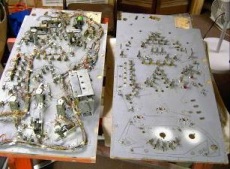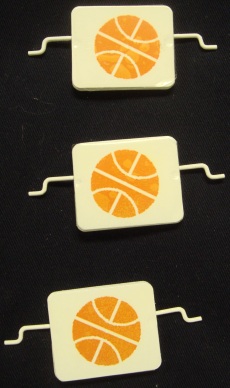Backglass
The backglass was in very good condition for a game this old. It has one small area where the paint is lifting. I sprayed the back with Krylon Triple Thick to protect it from further delamination. In doing this, I taped off the score and credit windows with masking tape and then sprayed the rear with three coats of Triple Thick, alternating the direction of my strokes with each coat.
Playfield
The original playfield was in pretty bad shape. I was able to find another blank one in better than average condition so I bought it. While not perfect, it was in above average condition and much better than the playfield I had. I then did a playfield swap. After swapping the playfield, I touched it up using acrylic paints and then clear-coated it. I will explain each of these steps.
Playfield Swap
The playfield swap wasn’t too difficult on this machine. To do this, I first set the two playfields up side by side on saw horses. Next, I took several pictures of both sides of the playfield so that if I needed it, I would have pictures to reference. second, I removed everything from the top of the playfield. I always do this anyway in order to clean the parts and get the unseen areas of the playfield clean. When I remove parts from the top, I make a diagram and label them in a notebook. For posts, there are basically four different screws used to hold them onto the playfield and I mark what type is used for each post. I also mark where each other piece of plastic and hardware goes.
Next, I clean the parts by tumbling the metal parts in a rock tumbler and using Novus #2 on the plastics pieces. Next, I flipped the playfield over. I marked where each screw goes on the adjacent playfield. I also mark the wires and their colors by using a pencil on the underside of the other playfield and in a drawing in my notebook. so, I have pictures, drawings, diagrams, and marks on the other playfield to help me in making the swap.
Fortunately, the better playfield still had its lamp sockets installed. so, I didn’t have to move them. I just clipped the wires from the lamp sockets on the old playfield and then re-stripped them for soldering later. Next, I removed hardware from the bottom of the playfield, including the bumpers, slings, flippers, drop target unit, etc. Next, I unscrewed all of the stand up targets and the switches. Finally, I unscrewed the white/gray wiring harnesses that hold the wiring to the playfield.
The next step is one that it is wise to have someone help you. I make sure that all of the targets and objects are free from protruding through the playfield. Then, with my partner’s help, I pick up the whole wiring “mess” and move it in one motion to the other playfield. In most cases, you can get it to stay in about the same position it was in on the other playfield. I then begin screwing everything back down. I usually use a drill with a phillips head bit on it to make it go faster.
The next part is the one that can be the most time consuming: re-soldering the wires. Be sure to do as much as you can now since it is easier to do while the playfield is flat and upside down. If there are especially difficult to reach areas, be sure to do them now. In my case, the only parts I left undone were parts that would protrude through the playfield, since I decided to clear coat the top. (I should have clear coated it before doing the swap.)
Just as a side-note, I had originally NOT planned to clear coat the playfield. If I had known I was going to do it, I would have probably done it before doing the swap. However, I had the game a part for a while before doing the swap and then I decided to go ahead and clear coat. so, I did the swap first. The rest of the hardware I installed after doing the clear coat.


